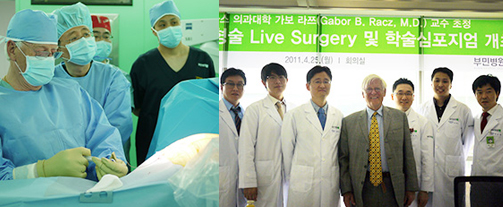Bumin Hospital Pain Management Center follows
evidence-based interventional pain medicine.
The use of minimally invasive techniques to relive pain is the best approach when simpler measures
such as physical therapy or medication fail.
Patients with unrelieved chronic pain
- Head, neck, and shoulder pain
- Lower back pain
- Neuropathic pain syndromes (post spinal surgery syndrome)

Advantages of treatment at Pain Management Center at Bumin
- Very little pain during the procedure
- General anesthesia is not necessary, done by local anesthesia
- No scar or bleeding, no risk of blood transfusion
- Very little complications or side effects
- Eligible for high risk patients with high blood pressure/diabetes/heart disease/osteoporosis
- Quick recovery (less than 30 min procedure with overnight hospital stay)
Neuroplasty
Special catheter with the diameter of 1mm is injected into the pain area
to release medication Effective for patients with spinal and shoulder pain,
post spinal surgery syndrome

Nerve Block
Injection of local anesthetic onto or near nerves to control pain. Effective for patients with spinal pain
(Disc, Spinal Canal Stenosis, Acute/Chronic Back Pain), Frozen Shoulder.
Nuceloplasty
Diameter of 0.8mm syringe is inserted into the spinal cord or nerve root and releases high frequency wave to eliminate the nucleus of disk,
causing the pain Effective for patients with contained or mildly herniated discs.
Intramuscular Injection
Medication is delivered directly into a muscle to reduce pain.
Trigger Point Injection (TPI)
Trigger point injections for pain are used to treat painful areas of muscle
that contain trigger points, or knots that form when muscles do not relax.
The knot can often be felt under the skin and may twitch involuntarily
when touched. The trigger point can trap or irritate surrounding nerves
and cause referred pain, or pain that is felt in another part of the body
